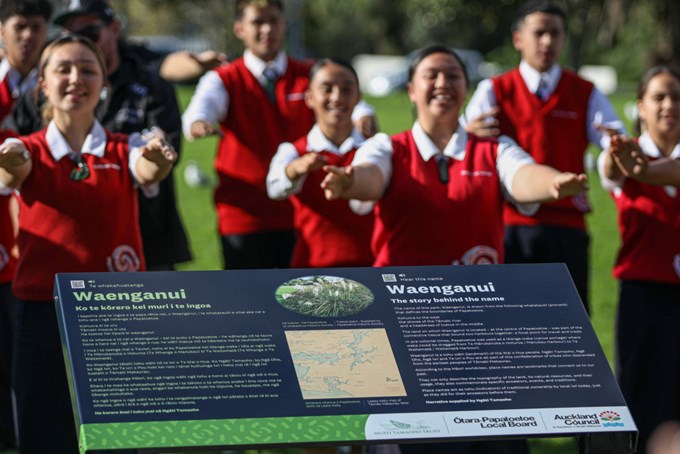Names harking back to history and stories treasured by Māori are being showcased in local parks across the Ōtara-Papatoetoe Local Board area.
Earlier this year, the local board adopted 18 names provided to it by mana whenua as part of the council’s cultural identity programme, Te Kete Rukuruku. Names for a further 32 parks are currently being worked on.
This week the first of these names is seeing the light with the unveiling of new signs bearing the new dual name of Waenganui / Allenby Park in Papatoetoe.
“Our local board is incredibly honoured to receive and reinstate these taonga, the names and histories of mana whenua. It gives us immense pleasure to share it with the people of our area through these names and stories taking pride of place in our local parks,” says Ōtara-Papatoetoe Local Board chair Apulu Reece Autagavaia.
“As a Samoan, I know how important names are. I've named my own children after places and important events back in Samoa.
“The distinct cultures in our local board area are our strength. Our community has told us that ensuring Māori arts, culture and history being more visible in public places is really important to them and this is a really simple but powerful way we can do that and something we will look after and treasure.”
Significant milestone for mana whenua
For Ngāti Tamaoho, who provided this name for the park, the ceremony was an important milestone.
“It is significant as we work with the local board together to learn more about the whenua, and this area and that has been a real focus of the korero today. For Ngāti Tamaoho that is exciting because focussing on the whenua is something we have really pushed for over the years,” says Ngāti Tamaoho Charitable Trust chairperson Tori Ngataki.
“I want to acknowledge the local board and all mana whenua who have been working really hard on this not just in this area but across Tāmaki Makaurau. It’s an awesome example of collaboration.”
The board selected Waenganui / Allenby Park to have a full suite of bilingual signs which will include:
- new entrance sign featuring the new dual name of the park Waenganui / Allenby Park
- an interpretive sign featuring the name and narrative in both te reo Māori and English, and QR code so people can scan on their phone to hear the correct pronunciation
- wayfinding information in both English and Māori on public facilities within the park
- regulatory signs, i.e. bylaw or alcohol ban information in English and te reo Māori.

For now, it will be the only park in the area to have a full suite of signs. Park name signs in the other sites selected for dual naming will be updated over time, with both their Māori and English names, as they are scheduled to be replaced.
See the list of names adopted in tranche one.
The story behind the name Waenganui
Waenganui is seen in the whakatauki (proverb) that defines the boundaries of Papatoetoe, which itself means 'grounds where toetoe grows'.
Kohuora ki te uru
Tāmaki moana ki uta
He toetoe hei tīpare ki waenganui
Kohuora to the west
the shores of the Tāmaki river
and a headdress of toetoe in the middle.
Te reo Māori is seen, heard, learnt, and spoken
“At the heart of our programme is that te reo Māori is seen, heard, learnt, and spoken as part of everyday life and the bilingual signs are a simple yet highly visible example of that,” says Te Kete Rukuruku programme manager for Auckland Council, Anahera Higgins.
But she says it not just about signs; this is a long-term vision to resurface the unique iwi identity and to develop our unique Māori identity and preserve these treasured narratives for future generations.
“One of the things I am extremely grateful for is that this is a programme led by mana whenua in partnership with Auckland Council. This has been a massive task for them, and their support and guidance as we navigated our way through this important mahi has been critical.
"It’s also exciting to have now had four local boards adopt their first lot of names and this will be our second fully bilingual park of the programme.”

About the Te Kete Rukuruku programme
In 2017 Auckland Council launched the Te Kete Rukuruku project, a culture and identity programme to collect and share the stories unique to Māori in Auckland. It is led by iwi, in partnership with the council and its local boards.
One component of this is a naming project which will see iwi and hapu names restored. In some cases, these names existed prior to the current names or may reflect a historical activity of the area prior to European settlement.
Short narratives explaining the significance of the names are also provided by mana whenua and give meaning and connection to the place.
In doing this, it honours and showcases the names and the rich mana whenua stories of Auckland – some of which have been lost over many years.
In December 2020, Whau Local Board unveiled bilingual signs in Tahurangi /Crum Park and earlier this year Māngere-Ōtāhuhu and Manurewa local boards adopted the first tranche of names and will be unveiling bilingual signs in the next few weeks.
The local boards currently participating in the naming part of the project are:
- Albert-Eden Local Board
- Devonport-Takapuna Local Board
- Franklin Local Board
- Henderson-Massey Local Board
- Hibiscus and Bays Local Board
- Kaipātiki Local Board
- Māngere-Ōtāhuhu Local Board
- Manurewa Local Board
- Maungakiekie-Tāmaki Local Board
- Ōtara-Papatoetoe Local Board
- Papakura Local Board
- Puketāpapa Local Board
- Whau Local Board
- Waitākere Ranges Local Board
- Waitematā Local Board.


